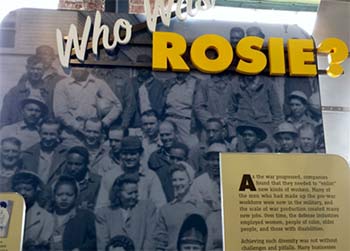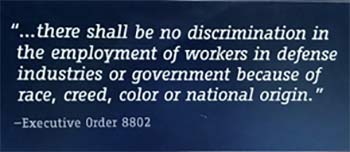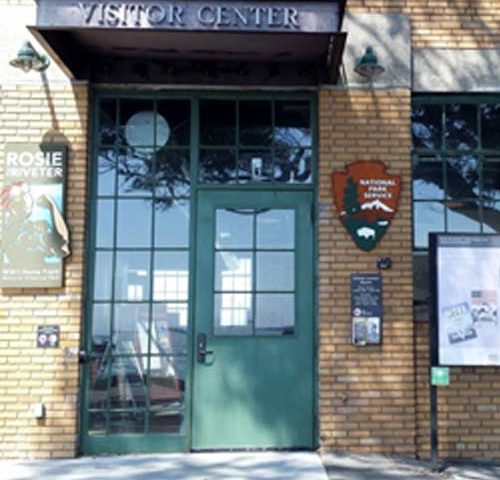Expect the Unexpected

Finding Courage in the Midst of Adversity
September 11, 2017
Cultivating the Seeds of Peace
September 22, 2017Recently I visited this expansive National Park in Richmond, CA, and was surprised by the many unexpected experiences from this spontaneous Saturday field trip. We had eagerly left a chilly, foggy morning along the coast and headed toward warmer surroundings and another World War II era adventure. I was not disappointed by this unplanned trip and my memories remain fresh and vivid.
My first visit to this new park along the historic Richmond waterfront happened in 2000 when my office was involved in the dedication of the newly completed Rosie the Riveter Memorial. Meeting the Rosies and the other women who were instrumental in the Home Front war effort was a powerful experience, but surprisingly it impacted me on a very personal level. As I heard these women’s remarkable stories about building the ships at the Kaiser Shipyards, I suddenly became curious about my father’s service in the Pacific. Had he been on one of those ships these women helped build? While that idea was safely deposited in the back of my mind, I never expected to get an answer.
Fast forward to May 2014 when I returned to the expanded park for the debut of their new interpretive exhibits highlighting the area’s other World War II Home Front involvement. My interest then had been to acknowledge the significant nontraditional roles that the women had filled to support the war effort. Now three years later I was back again, but this time I was looking more closely for clues connected to my father’s service.
My initial curiosity seventeen years before had now evolved into a post-retirement project of researching, writing, and telling my parents’ World War II stories. But there was still so much I yearned to know. Would I ever discover which troopship transported him from San Francisco to Australia? Was he on one of the 747 ships built here at the Kaiser Shipyards by the skillful women welders? While I still don’t have those answers, I recently learned about the transport that had brought him and 4,685 other soldiers safely home from Japan in November of 1945. The USS Admiral E. W. Eberle, which had been built at the nearby Bethlehem-Alameda Shipyards, set a trans-Pacific speed record of eleven days from Nagoya, Japan to Los Angeles. That reality alone made me grateful to be here revisiting this National Park, to walk on this sacred ground, and to remember the women and men here who invested so much time and energy into this war effort.
As I savored my late lunch outside at the Assemble Café housed in the former Ford Assembly Plant, it was hard to imagine that this peaceful bay was once a congested industrial area, producing ships and military equipment twenty-four hours a day. Sitting there I noticed a giant eucalyptus tree shading the entrance to the Education Center. I wondered how many people working in the area had paused to notice that tree or enjoy its shade during those hectic years. It was probably small then and seemly out of place in the bustle of all the factory surroundings. Yet it had been there as a silent observer of the urgent work being done.
Did it offer any solace for the workers who hurried by it every day? It had witnessed firsthand the many changes of that area and the people working there. But today it wore its green leaves with dignity and a slightly capricious style, and it beckoned me to think beyond the obvious. Why had my attention had been drawn to this solitary tree and what was it saying to me? Perhaps it was a solid reminder that it had been part of a turbulent past, and that it was still standing strong. Somehow I recognized that tree as a beacon of hope just as Park Ranger, Betty Reid Soskin had become.
Betty who turns 96 on September 22 began working as a ranger there when she was 85 and is now the oldest national park ranger in the U.S. I had heard about her through newspaper articles but didn’t realize that she would be giving a presentation that day. Luckily we got tickets to hear her speak about her experiences as a young African American woman living and working in the Richmond area during the war. None of the audience could believe her age as she barely looked 80, and her reflections and perceptions were indeed current and relevant. We did not want the conversations to end so we all gathered around her afterwards. There were still so many questions to ask, and this demure, articulate woman was extremely generous with her time, energy and responses. When we left the Education Center, we had all been moved by her passion, purpose, and ageless perspective. We were also keenly aware that this unassuming woman embodied the strength and courage of the quickly disappearing World War II generation.

Park Ranger Betty Reid Soskin with volunteer Ann Nutt
This had been an amazing day of unexpected discoveries as the history of that time and place came alive. I encourage you to plan a visit there soon. Take time to walk along the scenic San Francisco Bay Trail and breath in the beauty and peace of the area. Find that giant tree and see what it says to you. But most importantly plan your visit so you too can hear Betty Reid Soskin’s presentation “Of Lost Conversations.” It will inspire you to ponder more deeply her wise words and perspective. Go to www.nps.gov/rori for more information and to plan your visit.




